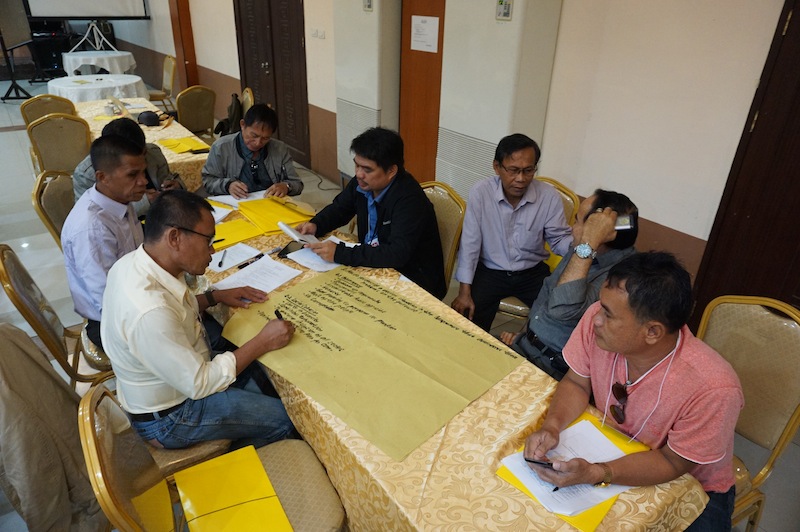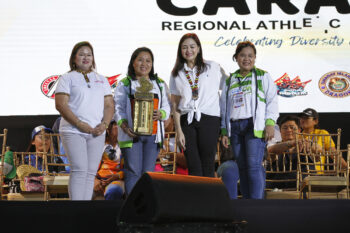COTABATO CITY (MindaNews / 18 November) — A clear vision of the future Bangsamoro is needed to find a common ground where the Bangsamoro people from various sectors can work together, a former Executive Secretary of the Autonomous Region in Muslim Mindanao (ARMM) said.
Lawyer Naguib Sinarimbo, who served as ARMM Executive Secretary from December 2009 to December 2011, said vision is what will unite the different stakeholders of the Bangsamoro.
“If they do not have that, if they don’t have anything specific as to what they want to achieve, they will be tied down to their daily activities. That will become a problem if we do not specify what we want because they will only mind their daily activities, and .. not where they want to go,” Sinarimbo said during the Bangsamoro Visioning Exercise of representatives from the Moro Islamic Liberation Front (MILF) at the Alnor Hotel here on November 16 to 18.
The visioning activity is part of a series of exercises involving Bangsamoro people from different sectors in the Autonomous Region in Muslim Mindanao (ARMM), in clusters such as Maguindanao, Cotabato City, and North Cotabato; South Cotabato, Sultan Kudarat, Sarangani, and General Santos; Davao Region; Lanao del Norte, Lanao del Sur, Marawi, and Iligan; Zamboanga City and Zamboanga Peninsula provinces; Sulu and Taw-Tawi; and Basilan and Palawan; as well as the Moro National Liberation Front (MNLF).
 Participants break out into groups to discuss their vision for the future of the Bangsamoro during the Bangsamoro Visioning Exercise held from November 16 to 18 at the Atnor Hotel in Cotabato City. MindaNews photo by ANTONIO L. COLINA IVRP
Participants break out into groups to discuss their vision for the future of the Bangsamoro during the Bangsamoro Visioning Exercise held from November 16 to 18 at the Atnor Hotel in Cotabato City. MindaNews photo by ANTONIO L. COLINA IVRP
Other stakeholders including religious, academe, professionals, political leaders, traditional leaders, women, youth, internally displaces persons, non-Moro IPs, civil society organizations, business groups, media, and persons with disabilities were also tapped to join the visioning exercises.
Sinarimbo said that common vision will bring them together on a common path to attain their desired developments in the Bangsamoro.
“We need to galvanize the community, the whole Bangsamoro that there is something that we have attained so that they will contribute to the efforts to get to where we want to be,” he said.
Sinarimbo said that setting a vision will enable them to monitor their progress and come up with specific steps that will help them achieve their goals during and even after the transition period.
“On the issue of governance, what do we want to see? In the next three years, what is it that we want to see in our governance? It’s important that we understand if we are progressing, if we are walking without even getting to our milestones. How close are we? What are the measures that we need to do so that we can get there?,” he asked.
Results of the visioning exercises will be consolidated and presented at a Bangsamoro Leaders’ Summit in early January, just before the plebiscite on January 21.
Anon A. Mohammad, provincial chair of the Social Welfare Committee of Tawi-Tawi, said she hopes leaders of the future Bangsamoro government will be responsive, honest, loyal, and just.
She said they want Bangsamoro people to finally enjoy a peaceful, harmonious and prosperous community.
Abdul Maomit Tomawis, provincial chair of the MILF’s Political Committee in Lanao del Sur, said they want to see high impact economic upliftment program for the Bangsamoro people to get them out of poverty.
He said he also wants to see full implementation of the Comprehensive Agreement on the Bangsamoro (CAB) that government and the MILF signed in 2014.
President Rodrigo Duterte signed into law the Organic Law for the Bangsamoro Autonomous Region in Muslim Mindanao, the enabling law of the CAB, which would pave the way for the creation of a new political entity that would replace the ARMM.
Datu Mussolini Sinsuat Lidasan, one of the commissioners of the Bangsamoro Transition Commission said during the visioning exercise of the Davao Region cluster on November 2 that the Bangsamoro’s proposed territorial jurisdiction covers the ARMM’s Basilan, Sulu, Tawi-Tawi, Lanao del Sur and Maguindanao, six towns in Lanao del Norte and 39 barangays in North Cotabato that voted for inclusion in the supposed expanded ARMM in 2001.
He said the six towns and 39 barangays will vote in a one-time plebiscite scheduled on January 21, 2019 to determine if majority of its residents want to be part of the Bangsamoro territory.
He added that areas outside the core territories can become part of the Bangsamoro territory through a resolution of the local government unit or upon petition of at least 10% of the registered voters and approved by the majority of the qualified voters cast in the plebiscite.
Under the future Bangsamoro government, Lidasan explained that residents will vote for the representatives of the 80-member Bangsamoro parliament, with chief minister and two deputy chief ministers shall be elected by majority votes from among the members of the Parliament.
He added the 80-member Bangsamoro Parliament is composed of 50% party representatives, 40% district representatives, and 10% reserved seats and sectoral representatives with two reserved seats for non-Moro IPs and settler communities and settler communities. (Antonio L. Colina IV / MindaNews)
